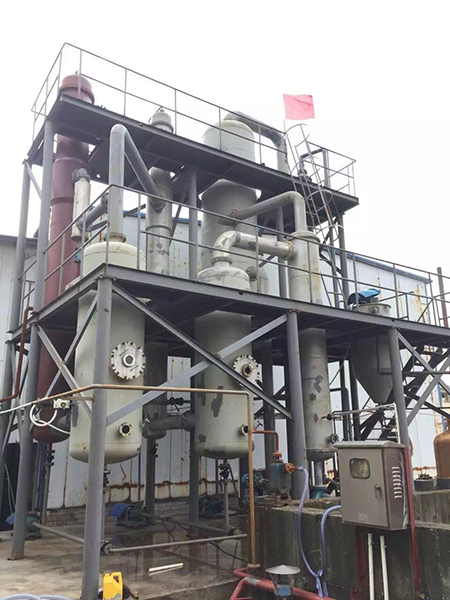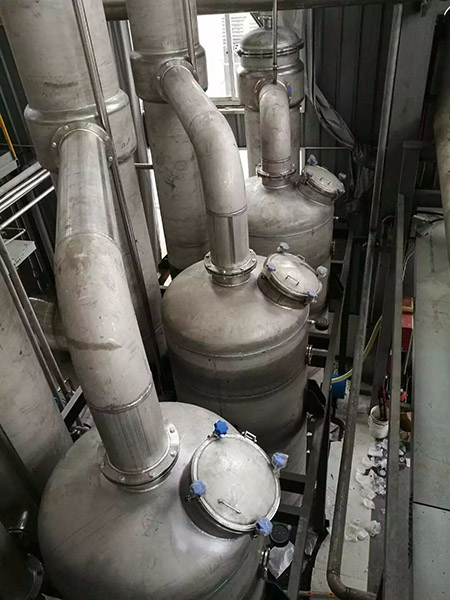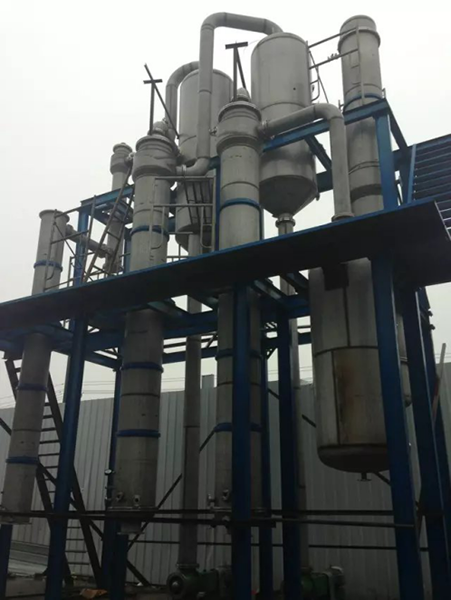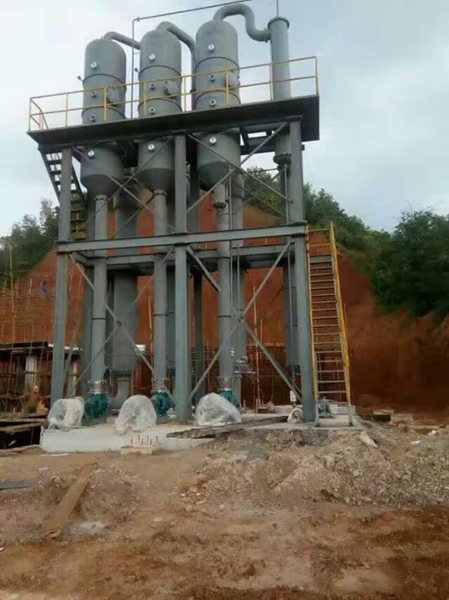Ammonia nitrogen wastewater treatment method
Mainly comes from chemical fertilizer, coking, petrochemical, pharmaceutical, food, the landfills, etc
A large amount of ammonia nitrogen wastewater discharge into water not only cause eutrophication of water bodies, also causing water black smelly, increase the difficulty and cost of water treatment, and even produce toxic to people and organisms, specific to ammonia nitrogen wastewater treatment process (2014 years ago) have biological method, chemical method and so on all sorts of treatment technology.
Ammonia nitrogen wastewater introduction:
Now with the rapid development of chemical fertilizer, oil, chemical industry, etc, the resulting high ammonia nitrogen wastewater have also become one of the industry development restriction factor;It is reported that in 2001 China's coast of red tides up to 77 times, ammonia nitrogen is one of the important reasons for the pollution, especially for the high concentration of ammonia nitrogen wastewater pollution. As a result, economic effectively control high concentration waste water pollution has become the current environmental protection workers research important topic. The formation of ammonia nitrogen wastewater is a common existence due to ammonia and inorganic ammonia, general PH in the neutral or more of the main sources of ammonia nitrogen wastewater is a common effect of inorganic ammonia and ammonia, PH under the condition of acid waste water in ammonia nitrogen is mainly due to the inorganic ammonia. There are two main types of the composition of ammonia nitrogen in the wastewater, one is the formation of ammonia ammonia nitrogen, the other is ammonia nitrogen which formed by inorganic ammonia, main is Ammonium sulphate, Ammonium chloride etc.
Treatment method
We emphatically introduce high ammonia nitrogen waste-water treatment method
Physic-chemical method
1. Blow-off method
Under alkaline conditions, it’s a kind of separation way which use the Gas liquid equilibrium relation between ammonia nitrogen concentration of the gas phase and liquid phase concentration , it is generally believed Blow-off is related to temperature, PH, gas liquid ratio.
2.Zeolite deamination method
Use of zeolite in cationic and NH4 + in waste-water exchange in order to achieve the purpose of denitrification. Application of zeolite to take off the ammonia method must consider the regeneration of zeolite, usually with renewable liquid method and burning method. When burning method is adopted to produce ammonia must be treated.
3.Membrane separation technique
A method of the ammonia nitrogen removal which using the choice of membrane permeability. This method is easy to operate, high recovery rate of nitrogen, no secondary pollution.
For example: gas water separation membrane removal of ammonia nitrogen.Ammonia nitrogen in water dissociation equilibrium, with increasing PH,ammonia in water form NH3 proportion higher , under a certain temperature and pressure, NH3 gas and liquid keep balance. According to the principle of chemical equilibrium is the lv. Chad(A.L.L E Chatelier) principle. All the balance in nature is relative and temporary. Chemical equilibrium only under certain conditions to maintain "if change one of the conditions of equilibrium systems, such as concentration, pressure or temperature, the balance will forwarder to the weaken change of direction.” Follow this principle to the following design concept: in the side of the membrane is a high concentration of ammonia nitrogen wastewater, on the other side is acidic aqueous solution or water. When the temperature of the left T1>20℃,PH1>9,P1>P2 maintain a certain pressure difference, the free ammonia in the effluent NH4 +Becomes NH3 ammonia, and the raw material liquid side interface diffusion to the surface of membrane, the membrane surface under the action of pressure difference, through the membrane pores, into absorbing liquid, quickly with H + ammonium reaction in acidic solution.
4. MAP precipitation method
Mainly using the following chemical reaction:Mg2++NH4++PO43-=MgNH4PO4
In theory , add Phosphorus salt and magnesium salt to a certain proportion to the wastewater containing high concentration ammonia, when [Mg2 + ][NH4+][PO43 -]>2.5×10–13, can generate magnesium ammonium phosphate(MAP), to remove ammonia nitrogen in wastewater.
5.Chemical oxidization preparation method
It’s a method which use strong oxidizer direct oxidation of ammonia nitrogen into nitrogen. Salient point is the use of chlorine in the water of the ammonia react with chlorine to produce ammonia ammonia, this method can also have antiseptic effect, but the residual chlorine will have an impact on fish, so it must be attached in addition to the residual chlorine facilities.
Biological nitrogen removal method
Traditional and newly developed has A/O denitrification technology, two pieces of activated sludge process, strong oxidation of aerobic biological treatment, shortcut nitrification denitrification, ultrasonic blow to take off the processing method of ammonia nitrogen method, etc.
1.A/O Process will be in series with the anoxic section and aerobic section, A section DO not above 0.2mg/L, O section DO=2~4mg/L. In the anoxic period of heterotrophic bacteria will hydrolyze he suspended pollutants (Starch, fiber, carbohydrate in sewage) and soluble organic into organic acid, make the macromolecular organic matter is decomposed into small molecule organic compound, insoluble organic matter into soluble organic matter,when these subjects enter into the aerobic anoxic hydrolysis product of aerobic treatment, improve sewage biodegradability, improve the efficiency of oxygen; In anoxic period of heterotrophic bacteria to protein, fat and other contaminants in ammoniation (organic N or amino acids in amino) on the chain of free ammonia (NH3 and NH4 +), Under the condition of sufficient oxygen, NH3 - N (NH4 +) will be changed into NO3 - under the nitrification of autotrophic bacteria. By circumfluence control returns to A pool, under hypoxic conditions, heterotroph denitrification will change NO3 - into molecular nitrogen (N2) complete C, N and O in the ecological cycle, realize the sewage disposal. Its characteristic is oxygen pool in advance, and the organic carbon in the wastewater is used by the denitrifying bacteria, can reduce the organic load of subsequent aerobic pond, aerobic denitrification reaction alkalinity can compensation pool to demand for alkalinity nitration. Anaerobic pool in the behind of Oxygen pool, can lead to further denitrifying residual organic pollutants removal, improve water quality.Higher removal rate of BOD5 can reach 90 ~ 95%, but the effect of nitrogen and phosphorus is a bit poor, denitrification efficiency is 70-80%, only 20 ~ 30% phosphorus.However, due to the A/O process is simpler, also has its outstanding characteristics, still is the widely used process.
2.Two sections of activated sludge process can effectively remove organic matter and ammonia nitrogen, among them the second delay aeration stage, residence time in 36 hours, sewage concentration under 2 g/l, can not mud or little mud to reduce sludge treatment cost.
3. Strong oxidation of aerobic biological treatment its typical representative have powder activated carbon (process) PACT
Powder activated carbon method to the aeration tank is the main characteristics of cic and powder activated carbon (PAC) using the microporous structure of the powder activated carbon is extremely rich and larger adsorption capacity, the dissolved oxygen and nutrient enrichment on the surface, for adsorption on the PAC microbial provide a good living environment so as to improve the degradation rate of organics.
At home and abroad in recent years, there have been some new denitrification process for nitrogen of high concentration of ammonia nitrogen wastewater treatment provides a new way. Basically have shortcut nitrification and denitrification, aerobic denitrification and anaerobic ammonium oxidation, etc.
4. Short-cut nitrification and denitrification
Biological nitrification and denitrification is the most widely used way of nitrogen removal of ammonia nitrogen in water, which is a kind of more economic method, its principle is to simulate the cycle of nitrogen in the natural ecological environment, using the combination of nitrifying bacteria and denitrifying bacteria, ammonia nitrogen in water can be converted to nitrogen denitrification in order to achieve the purpose. Due to ammonia oxidation process requires a lot of oxygen, aeration costs become the main means of this kind of denitrification. Shortcut nitrification and denitrification is to control the ammonia nitrogen oxide nitrosation stage, and then to denitrification, eliminating the traditional biological denitrification to nitrate by nitrite oxidation, reduction of nitrite two links (the ammonia nitrogen and nitrite nitrogen oxide on denitrifying). This technology has a big advantage: (1) save 25% oxygen supply, reducing energy consumption; (2) a 40% reduction in carbon source, In the case of low C/N realize denitrification denitrification; (3) reaction process, saving 50% of denitrifying pool volume; (4) to reduce the sludge production, nitrification process can be less 33% ~ 35% sludge, denitrification stage is about 55% less sludge production. Realization of shortcut nitrification and denitrification biological denitrification technology the key is to control the nitrification nitrite phase, to prevent further oxidation of nitrite.
5.Anaerobic ammonia oxidation (ANAMMOX)and full autotrophic denitrification(CANON)
Anaerobic ammonia oxidation is refers to under the condition of anaerobic ammonia nitrogen and nitrite as electron acceptor process directly oxidized into nitrogen.
Anaerobic ammonia oxidation (Anaerobicammoniaoxidation, for short ANAMMOX) refers to under anaerobic conditions, represented by Planctomycetalessp microbes directly with NH4 + as electron donor,NO2 - and NO3 - as electron acceptor, NH4 +, NO2 - and NO3 - into a biological oxidation process of N2.The process using the unique biological organism with nitrate as electron donor to ammonia nitrogen into N2, maximum limit realizes the circulation anaerobic nitrate N, this coupling process for from anaerobic nitrate nitrogen in waste water has a good prospect, for high ammonia nitrogen and low COD of wastewater due to the partial oxidation nitrates, greatly save the energy.There are many approaches now speculate that the anaerobic ammonia oxidation. First is the reaction of the hydroxyl of ammonia and nitrite generation N2O, and N2O can be further converted to nitrogen, ammonia oxidation of hydroxyl ammonium. Second is ammonia and ammonia reaction of hydroxyl hydrazine and hydrazine was converted into nitrogen and generate four reducing [H], reducing [H] is passed to the formation of hydroxyl ammonium nitrite reduction system. The third is: on the one hand, reduction of nitrite to NO, that is NO to N2O, reduction of N2O and N2; NH4 +, on the other hand, is oxidation as NH2OH, NH2OH, N2H4 N2H2 is converted to N2.The advantages of anaerobic ammonia oxidation process: can substantially reduce the oxygen consumption of nitration; Denitrification reaction of external electron donor; Can save the traditional nitrification and denitrification reaction in the process of the neutralization reagent; The little quantity of sludge.Anaerobic ammonia oxidation of deficiency is: so far, the strains of anaerobic ammonia oxidation reaction mechanism, to participate in all operation parameters and not clear.
Full autotrophic denitrification process was completed in a reactor, its mechanism is unclear. Hippen etc people found in limited dissolved oxygen (DO concentration of 0.8 1.0 mg/l) and without adding organic carbon source, more than 60% of the ammonia nitrogen into N2 and be able to remove. Also Helmer etc proved through the experiment under low DO concentration, the bacteria with nitrite ion as electron acceptor, ammonium ions as electron donor, end product for nitrogen. There is also experiments using fluorescence in situ hybridization technology monitoring microorganisms in full autotrophic denitrification reactor, found that even when the reactor at the stable stage in the case of limited aeration, the reactor remains has the activity of anaerobic ammonia oxidation bacteria, nitrifying bacteria. 85% of the ammonia nitrogen is converted into nitrogen. In view of the above theory, the entire autotrophic denitrification might include two steps is the first will be part of the ammonia nitrate nitrogen oxide to smoke, the second is the anaerobic ammonia oxidation.
6.Aerobic denitrification
Traditional nitrogen removal theory, denitrifying bacteria of facultative anaerobic bacteria, its respiratory chain under aerobic conditions with oxygen as the terminal electron acceptor in anaerobic conditions with nitrate as the terminal electron acceptor. So if for denitrification reaction, must under the anaerobic environment. In recent years, the phenomenon of aerobic denitrification have been found and reported, gradually get the attention of the people. Some aerobic denitrifying bacteria have been isolated, some can be simultaneously heterotrophic nitrification and aerobic denitrification (such as Robertson, separation, screening Tpantotropha. LMD82.5). So that it can be in the same reactor to realize simultaneous nitrification and denitrification in the true sense, simplifies the process, save the energy.
7.Ultrasound to remove ammonia nitrogen processing
Ultrasonic to remove method to remove ammonia nitrogen is a new and highly efficient high concentration of ammonia nitrogen wastewater treatment technology. It is on the basis of the traditional method to remove, the introduction of ultrasonic radiation wastewater treatment technology, ultrasonic and blow off technology combination and derived a processing method of ammonia nitrogen. The combination of the two methods not only improve the ultrasonic processing waste water to the problem of high cost, also makes up for the traditional blowoff technique of removing ammonia nitrogen defects, super living to remove method to insure the effect of treatment of ammonia nitrogen in at the same time also to have certain effect to improve the biodegradation of organic matter in wastewater.
Technical features:
(1) High concentration of ammonia nitrogen wastewater using high and new technology, ultrasonic denitrification technology in the 90 s, the total nitrogen removal efficiency in the 70 ~ 90%, do not need to adding the chemical, do not need to heat, low processing cost, stable treatment effect.
(2) Biochemical treatment using cyclic activated sludge method (CASS) process, construction cost is low, have unique biological denitrification function, low processing cost and stable treatment effect, resistance to impact load ability is strong, do not produce phenomenon of sludge bulking, nitrogen removal efficiency is more than 90%, to ensure that the ammonia nitrogen up to standard.
High salt waste water treatment methods
High salt waste water means the waste water whose total salt quality score is at least 1%. It mainly comes from chemical plants, oil, gas gathering and processing, etc. This kind of waste water contains many kinds of material (including salt, oil, organic heavy metals or radioactive material). Saline waste water produce widely, and water volume also increases year by year. So it is very important to lower organic pollutants in containing salt water to the environment. Using the biological method for processing, high concentration salts material has inhibitory effect on microorganism; using physicochemical method, it needs large investment, high operation cost, and difficult to achieve the desired cleaning effect; So using the biological method to deal with this kind of waste water, is the focus of the research at home and abroad.
the types of organic and chemical properties are different due to the different production process of organic matter in high salinity organic waste water, but the main containing salts materials are Cl - and SO42 -, Na +, Ca2 +, etc. Although these ions are necessary nutrients in microbial growth, play a promote enzyme reaction and play a influential role of balancing the membrane and adjusting osmotic pressure. But if these ions concentration is too high, can produce inhibition of microbial and toxic, mainly shows: high salt concentration, high osmotic pressure, plasmolysis caused by microbial cell dehydration; Salting out effect will reduce dehydro genase activity; High chloride ion are toxic to bacteria; If salt concentration is high, the density of waste water increases, the activated sludge is easy loss of buoyancy, which seriously affects the purification efficiency of biological treatment system.
Aiming at the problem of how to deal with high salt waste water, we introduced a method of processing--the distillation desalination method:
Distillation is one of the most ancient and commonly used method of desalination.The industrial waste water distillation desalination technology were mostly developed from the basis of seawater desalination technology .Distillation is to heat the salty water and make it boiling evaporating, then to condensate the vapor into fresh water. Distillation is the earliest use dilution method, whose advantage is simple structure, easy operation, good quality of fresh water, etc. Distillation has a lot of kinds, such as multiple effect evaporation, multi-stage flash evaporation, compressed air distillation, membrane distillation, etc
Multiple effect evaporation(MED)
Multi-effect evaporation is to make the heated salt water evaporating in several series of evaporator, the vapor out from prior evaporator will be act as heating source of the inferior evaporator, and then condensate to fresh water.The low-temperature multi-effect distillation is one of the most energy saving distillation method. As energy saving, the low-temperature multi-effect distillation technology develops rapidly in recent years, equipment scale grows gradually and cost lowers. The main development trend is improving the device single water capacity, reducing the project cost by using cheap materials , improving the operating temperature and heat transfer efficiency, etc.
Multi-stage flash evaporation
In seawater desalination, for example, after heating raw material to a certain temperature, to put it into flash chamber. As the flash chamber pressure is controlled in below the saturated vapor pressure which is corresponding to hot brine temperature, the hot brine rapidly becomes to hot and partial gasification after going into the flash chamber, thus reduce the temperature of hot brine itself, the produced steam will condensate to the needed fresh water. Multi-stage flash is based on this principle, to make hot water flowing in turn through a number of flash chambers which pressure decreases gradually,
Evaporation temperatue reduces, and brine concentration increases step by step, until temperature is close to natural seawater temperature (but above).
Multi-stage flash is one of the more mature technology in the desalination industry, developed from a serious complication scale faults for multi-effect evaporation. MSF is applied and developed once comes, with the advantages of simple and reliable equipment、high safety、good antiscaling performance、large elasticity of operation and can use low heat and waste heat, which is suitable for large and super large desalination device, and mainly used in the gulf states.
Vapor compressed condensation
Vapor compressed condensation desalination technology is to preheat brine, put brine into evaporator and evaporation in the interior of the evaporator. The secondary vapor produced by evaporator is introduced into the heating side of evaporator by increasing pressure of compressor. After condensating from vapor, it will be output as product water for recycling using of heat energy. When it acts as circulating cooling water desalting recovery process, can make the harmful ingredients in cooling water concentrated emissions, and more than 95% of the domestic sewage will be recycled in the form of condensate liquid, as circulating water and boiler make-up water to return to the system.This process has extremely high requirements for equipment materials, needs large amounts of heat during operation, but has shortcomings of one-time investment and high operation cost, which can only be used in power plants in the special water shortage area .









